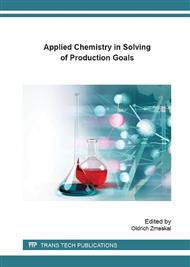[1]
Information on http: /faostat3. fao. org/compare/E.
Google Scholar
[2]
Food consumpution in the SR, Statistical Office of Slovak Republic.
Google Scholar
[3]
B. McKevith, Nutritional ascpets of cereals, Nutrition Bulletin 29(2004) 111-142.
Google Scholar
[4]
L. Cordain, Cereal grains: humanity's double-edged sword, World Rev. Nutr. Diet 84 (1999) 19–73.
DOI: 10.1159/000059677
Google Scholar
[5]
P. Sood, A. Bhattacharya, A. Sood, Problems and possibilities of monocot transformation, Biol. Plant 55 (2011) 1-15.
DOI: 10.1007/s10535-011-0001-2
Google Scholar
[6]
D. Mihalik, M. Gubisova, T. Klempova, M. Certik, K. Ondreickova, M. Hudcovicova, L. Klcova, J. Gubis, I. Dokupilova, L. Ohnoutkova, J. Kraic, Transformation of barley with artificial gene encoding for delta-6-desaturase, Biol. Plantarum 58 (2014).
DOI: 10.1016/j.copbio.2013.05.390
Google Scholar
[7]
R.R. Singhania, A.K. Patel, C.R. Soccol, A. Pandey, Recent advances in solid-state fermentation, Biochem. Eng. J. 44 (2009) 13-18.
DOI: 10.1016/j.bej.2008.10.019
Google Scholar
[8]
M. Čertík, T. Klempová, L. Guothová, D. Mihálik, J. Kraic, Biotechnology for the functional improvement of cereal-based materials enriched with polyunsaturated fatty acids and pigments, Eur. J. Lipid. Sci. Tech. 115 (2013) 1247-1256.
DOI: 10.1002/ejlt.201300092
Google Scholar
[9]
L. Sláviková, M. Čertík, S. Masrnová, B. Škrinárová, Ľ. Valík, J. Šajbidor, Effect of moisture and water activity on g-linolenic acid production in solid state fermentation, Chem Listy 96 (2002) 81-182.
Google Scholar
[10]
T. Klempova, E. Basil, A. Kubatova, M. Certik, Biosynthesis of gamma-linolenic acid and beta-carotene by Zygomycetes fungi, Biotechnol. J. 8 (2013) 794-800.
DOI: 10.1002/biot.201200099
Google Scholar
[11]
C.L. Gerez, M.I. Torino, G. Rollán, G. Font de Valdez, Prevetion of bread mould spoilage by using lactic acid bacteria with antifungal properties, Food Control, 20 (2009) 144-148.
DOI: 10.1016/j.foodcont.2008.03.005
Google Scholar
[12]
L.A.M. Ryan, F. Dal Bello, A.K. Arendt, The use of sourdough fermented by antifungal LAB to reduce the amount of calcium propionate in bread, Int. J. Food Microbiol., 125 (2008) 274-278.
DOI: 10.1016/j.ijfoodmicro.2008.04.013
Google Scholar
[13]
C.G. Rizzello, A. Cassone, R. Coda, M. Gobbetti, Antifungal activity of sourdough fermented wheat germ used as an ingredient for bread making, Food Chem., 127 (2011) 952-959.
DOI: 10.1016/j.foodchem.2011.01.063
Google Scholar
[14]
A. Corsetti, L. Settanni, Lactobacilli in sourdough fermentation, Food Res. Int., 40 (2007) 539-558.
DOI: 10.1016/j.foodres.2006.11.001
Google Scholar
[15]
M. Čertík, M., Z. Adamechová, L. Guothová, Simultaneous enrichment of cereals with polyunsaturated fatty acids and pigments by fungal solid state fermentations, J. Biotechn 168 (2013) 130-134.
DOI: 10.1016/j.jbiotec.2013.03.016
Google Scholar
[16]
STN46 1011-37. Testing of cereals, pulses and oilseed. Part 37: Polarometric determination of starch accordign to Ewers.
Google Scholar
[17]
A. Moheb, M. Grondin, R.K. Ibrahim, R. Roy, F. Sarhan, Winter wheat hull (husk) is a valuable source for tricin, a potential selective cytotoxic agent, Food Chem., 138 (2013) 931-937.
DOI: 10.1016/j.foodchem.2012.09.129
Google Scholar
[18]
L. Fu, J. Tian, C. Sun, Ch. Li, RVA and pharinograph properties Study on Blends of Resistant Starch and Wheat Flour, Agr, Sci, China, 7 (2008) 812-822.
DOI: 10.1016/s1671-2927(08)60118-2
Google Scholar
[19]
M.L. Sudha, R. Vetrimani, K. Leevathi, Influence of fibre from different cereals on the rheological characteristics of wheat flour dough and on biscuit quality, Food Chem., 100 (2007) 1365-1370.
DOI: 10.1016/j.foodchem.2005.12.013
Google Scholar


